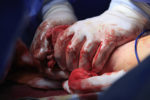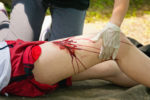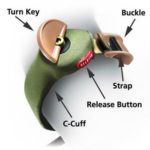Internal bleeds are very serious as the casualty is still technically losing blood, even if it is still technically inside their body. Internal bleeding is often very hard to detect, as no blood can be seen leaving the body. Instead, it pools inside the body, building up over time. The bleeding can occur around organs, […]
Articles Tagged: Blood
Sickle Cell Anaemia
Sickle Cell Anaemia affects the haemoglobin in red blood cells, which carry oxygen from the lungs to all parts of the body. Sickle cell anaemia is a genetic condition where the red blood cells are not a normal (biconcave) shape. Instead, they look like sickles. Due to it being genetic, people are born with this […]
Knife Wounds
When dealing with any sort of victim of a knife attack, your safety must come first. There is no point seeing someone get stabbed, immediately running over to help them and then getting stabbed yourself as well. So, always make sure that the assailant has left the area before you approach the patient. If you […]
Blood Loss
Excessive blood loss does not just happen externally when the skin is broken. Blood can be lost inside the body as well, which is called internal bleeding. The big problem in both is recognising that severe blood loss is possible or actually happening. It’s best to assume the worst and treat as if there is […]
The Circulatory System
The heart is one of the most important organs in mammals and is made of muscular tissue. It pumps blood around the body to other vital organs, giving them oxygen for aerobic respiration. In one circulation of the body, blood enters and leaves the heart twice. Arteries and veins carry blood around the body. Arteries […]

Haemocap
Imagine you are a first aider. You will know that most lacerations will stop bleeding when applying pressure. But what if you have to continue to press on the wound for several minutes? This would waste precious time! Haemocap Multisite is a unique, patented, compression device useful for traumatic bleeding wounds. Instead of using traditional […]

Amputated limbs
Amputated limbs are something that you do not come across very often, especially in day-to-day life. It is most common in machinery accidents and in traumatic car crashes. However it is something that you may come across, so you should know how we deal with amputated body parts. The first thing to understand is that […]

Coagulopathy
Coagulopathy is a condition in which the blood’s ability to coagulate – clot – is impaired. This would mean that if someone had a serious bleed, the bodies’ ability to form clots and stop the bleeding would be reduced. This condition can cause prolonged or excessive bleeding, which occurs typically during any sort of medical […]

Tourniquets
Tourniquets can only be used on arms or legs. With other parts of the body, you would have to use direct pressure and haemostatic dressings. Tourniquets control excessive bleeding that you cannot control with direct pressure and pressure dressings. These types of bleeds are classified as catastrophic bleeds. They include amputations, stab wounds, gunshot wounds, […]

Improvised Tourniquets
If you do not have a commercial tourniquet, you can create improvised tourniquets using something flexible such as a triangular bandage, a scarf or a necktie. However, you should not use a thin flexible material such as a shoelace, string or a wire. If you were to use something like this, you may end up […]
